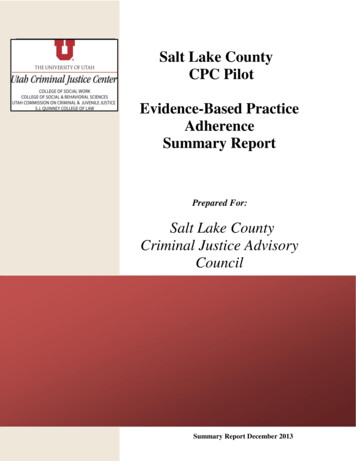
Transcription
Salt Lake CountyCPC PilotEvidence-Based PracticeAdherenceSummary ReportPrepared For:Salt Lake CountyCriminal Justice AdvisoryCouncilSummary Report December 2013
Salt Lake CountyCPC PilotEvidence-Based Practice AdherenceSummary ReportRob Butters PhD, LCSWDirector and Primary InvestigatorJennifer Loeffler-Cobia, M.S.Senior Research AnalystJennie Hall, M.S.Research AnalystAudrey Hickert, M.A.Research Assistant ProfessorTimothy Weyman, LCSWResearch AnalystDecember 2013Utah Criminal Justice Center, University of Utah
Table of ContentsPageTable of Contents . iAcknowledgements . iiIntroduction . 1Background . 1Evidence-Based Practice - Quality Improvement Process . 1Correctional Program Checklist . 3Description of the Five Participating Programs . 5Methods . 8Evidence-Based Practices Adherence Program Evaluations . 8Program Director Focus Group . 8Results . 10Summary of Evidence-Based Practice Adherence Evaluations . 10Summary of Program Director Focus Group Findings . 17Discussion and Conclusion . 21References . 24AppendicesAppendix 1. EBP-QIP: Nine Stages . 25TablesTable 1.Table 2.Table 3.Table 4.Table 5.Table 6.Types of Programs Assessed for CPC Development . 4Program Participation . 9Focus Group Questions . 9Consolidated Responses: Focus Group Question 1 . 17Consolidated Responses: Focus Group Question 2 . 19Consolidated Responses: Focus Group Question 3 . 20FiguresFigure 1. UCJC EBP-QIP Model . 2Figure 2. Salt Lake Co. 2013 Programs’ Area Adherence Avg Compared to National Avg . 10i SaltLake County CPCSummary ReportPilot: Evidence-BasedPractice Adherence
AcknowledgementsAcknowledgementsWe would like to thank the Salt Lake County Criminal Justice Advisory Council (CJAC) and theirCoordinator David Litvack for their ongoing support and for allowing us the opportunity to complete theEvidence-Based Practice (EBP) program evaluation with county criminal and social justice providers, aswell as provide ongoing consultation and quality improvement technical assistance. We especially wouldlike to thank the program directors and staff of the following five programs who volunteered to participateand graciously hosted us during the evaluation site visits and who have worked diligently on improvingtheir programs to adhere to evidence-based practices: First Step House, Life Skills at Oxbow,Correctional Addiction Treatment Services (CATS) at Oxbow, Criminal Justice Services DomesticViolence (CJS-DV) Unit, and Co-Occurring Reentry and Empowerment (CORE) at Valley Mental Health(VMH).ii S a l tLake County CPC Pilot: Evidence-BasedSummary ReportPractice Adherence
Introduction and BackgroundIntroductionBuilding an evidence-based criminal justice system requires more than just having an understanding ofthe “what works” research. It requires a commitment to fundamentally changing the way criminal justiceorganizations operate and the way that funders, providers, and other stakeholders work together. In thepast year, the Salt Lake County Criminal Justice Advisory Council (CJAC) has workedassiduously toward the goal of having their criminal justice providers become evidence‐based andcontribute to improved public safety in Utah. To this end, five Salt Lake County criminal justiceagencies were selected to participate in a program evaluation and quality improvement processwith the Utah Criminal Justice Center (UCJC) to enhance their service delivery to be moreconsistent with evidence‐based practices (EBP). This report is a summary of the five programevaluations and results of a focus group conducted with program directors. This evaluation providesvaluable information on where not only providers can improve their practices, but where the criminal andsocial justice system can improve as well. The recommendations provided in this report will act as aroadmap for sustainable implementation and replication of evidence‐based practices in Salt Lake Countyand to develop a just, effective, and evidence-based system.BackgroundIn January 2013, the CJAC asked UCJC to evaluate Salt Lake County’s criminal and social justiceprograms on their adherence to EBP and provide ongoing quality improvement technical assistance. Fiveprograms were selected to participate in the process: First Step House, Life Skills at the Oxbow Jail,Correctional Addiction Treatment Services (CATS) at the Oxbow Jail, Criminal Justice ServicesDomestic Violence (CJS-DV) Unit, and Co-Occurring Reentry and Empowerment (CORE) at ValleyMental Health.The method chosen to evaluate the programs was the Correctional Program Checklist (CPC) developedby the University of Cincinnati. The CPC was developed to assess how closely correctional programsadhere to known principles of effective intervention that have been shown to reduce criminal recidivism.The Correctional Practice Checklist sub-section below describes the CPC in greater detail.The purpose of this report is two-fold: 1) to summarize the program findings from the five programevaluations conducted with Salt Lake County criminal and social justice providers in 2013, and 2) toprovide the findings of the program director focus group, conducted in November 2013, that exploredbenefits and barriers to the program evaluation and quality improvement process. The final section of thisreport, Discussion and Conclusion, integrates the key findings from the Summary of the EBP ProgramEvaluations section with the feedback on the process and suggestions from the Program Director FocusGroup Findings to make recommendations for next steps.Evidence-Based Practice - Quality Improvement ProcessPurposeThe purpose of the Evidence-Based Practice – Quality Improvement Process (EBP-QIP), developed bythe UCJC, is to improve the effectiveness of interventions delivered to both juvenile and adult offenders.Because the EBP-QIP is a learning process for organizations, it is expected to both emphasize effectivepractices and outcomes, and to identify areas of improvement for program fidelity and outcomes. It isonly by looking at all facets of program performance that organizations will learn how to improve thedelivery of their interventions.1 SaltLake CountySummary ReportCPC Pilot: Evidence-BasedPracticeAdherence
Introduction and BackgroundThis process is helping Salt Lake County criminal and social justice providers to function moreeffectively by providing opportunities to clearly define their target population, the services delivered, andexpected client outcomes by assessing, planning, monitoring, and making improvements based onevidence/data. This process allows these individual providers the opportunities to put the evidence intheir practices and continually make evidence-based improvements.ProcessEBP-QIP uses an organizational leadership approach to accomplish intervention improvements. EBPQIP acknowledges that the leadership and intervention staff are the experts in the services they provide toclients. It creates an environment in which those closest to the service delivery are also actively engagedin assessing practices and policies, and making improvements based on those assessments. Moreover, theEBP-QIP transforms providers who are compliance-focused into true learning organizations that rely ontheir mission, vision, and values to constantly improve their practices.Figure 1. UCJC EBP-QIP ModelChange and improvements that the five providers are making occurby following sequential steps that focus on establishing procedures,empowering staff, placing clients first, and achieving a long-termorganizational commitment to data-driven decision making (seeFigure 1. UCJC EBP-QIP Model).1 These steps include:Step 1: Assessing EBP Adherence: Assess, via CPC, howinterventions are being operationalized and adhering to EBP;Step 2: Developing an EBP Quality Improvement Plan: Developan action plan based on CPC assessment results with goals and tasksfor improving service delivery;Step 3: Monitoring Improvement Plan Goals: Monitor EBP quality improvement plan to ensureimprovements are implemented; andStep 4: Assessing Program Impact: Use outcome data to determine if improvements were successful(e.g., pre-post assessments, recidivism data).To assist the providers through the EBP-QIP steps the UCJC team has developed nine stages to buildquality improvement capacity within provider organizations. Providers move through the stages at theirown pace with technical assistance from the UCJC team. These stages are used as an internal benchmarkto track the progress of Salt Lake County providers as they implement their EBP-QIP. The nine stagesare (for more detailed information on the EBP-QIP Nine Stages please see Appendix A): Stage One:Stage Two:Stage Three:Stage Four:Stage Five:Stage Six:Leadership EBP-QIP OverviewAssess EBP AdherenceEBP Adherence Report Feedback from LeadershipDevelop Quality Improvement TeamDevelop Program Logic ModelImplement an EBP Quality Improvement Plan1EBP-QIP Model is a modified version of the Quality Improvement Initiative (Qii). Developed by Jennifer Loeffler-Cobia, Trish Campie, TeriDeal, and Anne Rackow at the National Center for Juvenile Justice.2 SaltLake CountySummary ReportCPC Pilot: Evidence-BasedPracticeAdherence
Introduction and Background Stage Seven: Stage Eight: Stage Nine:Develop Outcome Data Collection Plan and Collect Outcome DataIncorporate Feedback Loop and Review ProcessRe-Assess Adherence and Evaluation EffectivenessCorrectional Program Checklist (CPC)2As the first step to implementing and sustaining EBP (mentioned above), Salt Lake County providerswere assessed on their current state of EBP adherence. To do this the UCJC team was trained to use theCorrectional Practice Checklist (CPC).3 The CPC is a tool developed to assess correctional interventionprograms, and is used to ascertain how closely correctional programs meet known principles of effectiveintervention.Programs that adhere to the principles of effective intervention are more likely to impact criminalreoffending (see Andrews & Bonta, 2003 for a review). Specifically, research suggests that cognitivebehavioral and social learning models of treatment for offenders are associated with considerablereductions in recidivism (Gendreau, 1996; Smith, Goggin, & Gendreau, 2005). As such, during the lastseveral years legislatures and policymakers have requested that interventions are consistent with theresearch literature on evidence-based practices.Several recent studies conducted by the University of Cincinnati on both adult and juvenile programswere used to develop and validate the indicators on the CPC.4 These studies found strong correlationswith outcome between overall scores, domain areas, and individual items (Holsinger, 1999; Lowenkamp,2003; Lowenkamp & Latessa, 2003, 2005a, 2005b).The CPC is divided into two basic areas: CAPACITY and CONTENT. The CAPACITY area is designedto measure whether a correctional program has the capability to deliver evidence-based interventions andservices for offenders. There are three domains in the capacity area including: (1) Leadership andDevelopment; (2) Staff; and (3) Quality Assurance. The CONTENT area focuses on the substantivedomains of: (1) Offender Assessment; and (2) Treatment Characteristics. This area evaluates the extent towhich the program meets the principles of risk, need, responsivity, and treatment. There are a total ofseventy-seven indicators, worth up to 83 total points. Each area and all domains are scored and rated aseither “HIGHLY EFFECTIVE" (65% to 100%); "EFFECTIVE" (55% to 64%); "NEEDSIMPROVEMENT" (46% to 54%); or "INEFFECTIVE" (45% or lower).The scores in all five domains are totaled, and the same scale is used for the overall assessment score. Itshould be noted that not all of the five domains are given equal weight, and some items may beconsidered NOT APPLICABLE, in which case they are not included in the scoring.There are several limitations to the CPC that should be noted. First, the instrument is based upon an“ideal” program. The criteria have been developed from a large body of research and knowledge thatcombines the best practices from the empirical literature on “what works” in reducing recidivism.Second, as with all applied research, objectivity and reliability are an issue. Although steps are taken toensure that the information gathered is accurate and reliable, given the nature of the process, decisions2Portions of this report that pertain to standard CPC issues were provided by University of Cincinnati, Corrections Institute, and are used with theInstitute’s permission.3The CPC is modeled after the Correctional Program Assessment Inventory developed by Gendreau and Andrews; however, the CPC includes anumber of items not contained in the CPAI. In addition, items were deleted that were not found to be positively correlated with recidivism.4These studies involved over 40,000 offenders (both adult and juvenile), and over 400 correctional programs, ranging from institutional tocommunity-based. All of the studies are available at www.uc.edu/criminaljustice. A large part of this research involved the identification ofprogram characteristics that were correlated with recidivism outcome.3 SaltLake CountySummary ReportCPC Pilot: Evidence-BasedPracticeAdherence
Introduction and Backgroundabout the information and data gathered are invariably made by the assessor(s). Third, the process is timespecific. That is, the assessment is based on the program at the time of the assessment. Though changes ormodifications may be under development, only those activities and processes that are present at the timeof the review are considered for scoring. Fourth, the process does not take into account all “system”issues that can affect the integrity of the program. 5 Lastly, the process does not address why a problemexists within a program.Despite these limitations, there are a number of advantages to this process. First, the criteria are based onempirically derived principles of effective programs. Second, all of the indicators included in the CPC arecorrelated with reductions in criminal recidivism. Third, the process provides a measure of programintegrity and quality; it provides insight into the “black box” of a program, something that an outcomestudy alone does not provide. Fourth, the results can be obtained relatively quickly. Fifth, it identifiesboth the strengths and weaknesses of a program; it provides the program with an idea of what it is doingthat is consistent with the research on effective interventions, as well as those areas that needimprovement. Sixth, it provides useful recommendations for program improvement. Finally, it allows forcomparisons with other programs that have been assessed using the same criteria. Furthermore, sinceprogram integrity and quality can change over time, it allows a program to reassess its progress.Norm InformationResearchers at the University of Cincinnati have assessed over 500 programs nationwide and havedeveloped a large database on correctional intervention programs.6 Approximately 7 percent of theprograms assessed have been classified as “HIGHLY EFFECTIVE,” 17 percent “EFFECTIVE,” 31percent “NEEDS IMPROVEMENT,” and 45 percent “INEFFECTIVE.”7 Table 1 represents the types ofprograms that were assessed to develop and refine the CPC:Table 1. Types of Programs Assessed for CPC Development Types of Programs Assessed for CPC DevelopmentBoot Camps Residential Substance Abuse ProgramsCommunity Correctional Facilities Residential Substance Abuse Programs forHabitual Drunk DriversCorrectional Education Programs School-Based ProgramsDay Reporting Centers Sex Offender ProgramsDiversion Programs Therapeutic Communities, both institutionaland community-basedGroup Homes Work Release FacilitiesIntensive Supervision Units Halfway Houses5One of the purposes of this summary report is to address this limitation of the CPC and provide some system recommendations to Salt LakeCounty to assist individual programs in overcoming system barriers to meeting evidence-based principles.6Several versions of the CPAI were used prior to the development of the CPC. Scores and averages have been adjusted as needed.7The previous categories used were “very satisfactory,” “satisfactory,” “needs improvement,” and “unsatisfactory.”4 SaltLake CountySummary ReportCPC Pilot: Evidence-BasedPracticeAdherence
Introduction and BackgroundAssessment ProcessProgram site visits were conducted at each of the five programs. The assessment team consisted of 2-4researchers from UCJC who each score the CPC independently. Each assessment consisted of structuredinterviews with staff members, administration, program participants, and treatment providers. Additionaldata were gathered via the examination of representative client files (open and closed) and the review ofrelevant program materials (e.g., treatment manuals, course syllabi, ethical guidelines, and staff surveys).Data from the various sources were used to calculate a consensus CPC score for each program and toprovide the recommendations provided to each specific program.Quality Improvement ImplementationOnce the program evaluations were completed (Stage 2) the UCJC team developed a comprehensivereport detailing areas of strength and areas where improvements could be made to better adhere to EBP.Reports were provided to each program’s leadership team (Stage 3). The UCJC team then began to workwith each provider on developing an EBP quality improvement team, logic model, and implementationplan (Stage 4, 5, and 6) and helping them work through all the stages mentioned above. Most providersare currently working on their logic models, implementation plan and making improvements.Description of the Five Participating ProgramsThe following five programs participated in the program evaluations and subsequent quality improvementprocesses during the first year of the EBP-QIP process with Salt Lake County adult criminal and socialjustice programs. A brief description of each program is provided in this section from the time of theirprogram evaluation site visit. The Summary of Evidence-Based Practices Adherence ProgramEvaluations results section describes primary program strengths and areas for improvement regardingsystem issues that arose across the five programs evaluated.1) Co-Occurring Reentry and Empowerment (CORE) at Valley Mental Health (VMH)The Co-Occurring Reentry and Empowerment (CORE) program is an un-locked residentialtreatment facility that offers services to adult male criminal offenders suffering from co-occurringsubstance abuse and mental health disorders. The CORE program is managed by the ValleyMental Health (VMH) Forensics Department and is a voluntary program, although all participantsare involved in the criminal justice system to varying degrees. The program is designed toprovide participants with wrap-around treatment services, both on-site and in the community,while providing support and skills development in a residential setting. Additional treatment isalso provided by VMH. The ultimate goals of the CORE program are successful re-entry into thecommunity and reduction in recidivism. The program accomplishes these goals by empoweringconsumers, improving emotional functioning, and promoting accountability. In addition toservices provided on-site, clients also receive alcohol and drug treatment at the VMH Forensicsoutpatient facility.The CORE program is a 3- to 6-month long program with an average length of 4 months,although time can be extended based on clients’ individual needs. The CORE has been inoperation for four years and employs six full-time employees and four part-time employees and issupervised by a program director.5 SaltLake CountySummary ReportCPC Pilot: Evidence-BasedPracticeAdherence
Introduction and Background2) Correctional Addiction Treatment Services (CATS) at OxbowThe CATS program at Oxbow Jail is a secure correctional-based treatment facility targeted atoffenders with substance use disorders. The curriculum was modeled after the Helping OffendersParole Effectively (HOPE) program at Gunnison Prison, which utilizes a therapeutic community(TC) approach. Therapeutic communities usually consist of group-based residential treatmentprogram where participants increase levels of personal and social responsibility through ahierarchical model of care. A distinct feature of TCs, compared to other treatment programs, isthe use of the “community” in structured and unstructured ways as the primary therapeutic tool toinfluence attitudes, perceptions, and behaviors associated with drug use and antisocial attitudes.The CATS program at Oxbow is a 90-day program for volunteers and court-ordered participants.During the time offenders are in CATS, male participants are separated from the general jailpopulation at the Adult Detention Center (ADC) and live in their own pods of the Oxbow Jail.The CATS program is in its fourteenth year of operation and employs ten full-time staff (1program director, 4 full-time therapists, 2 case managers, 2 roving therapists, and 1 support staff).3) Criminal Justice Services Domestic Violence (CJS-DV) UnitThe CJS-DV unit is a program within the Salt Lake County Criminal Justice Services (CJS)Probation department that provides case management services to participants who have beenconvicted of a class “A” or “ B” misdemeanor Domestic Violence charge. The CJS-DV unitis a specialty program, set apart from the other probation units and operates under best practicesfor supervising misdemeanor Domestic Violence offenders.The CJS-DV unit provides 12- to 24 -months of court-ordered case management. Intensiveservices are provided for at least 90-120 days and can continue throughout the entireprobation sentence, depending on clients’ needs. Clients are required to meet with casemanagers face-to-face every 2 weeks until the client has established a history of compliance (atleast 90 days), at which point contact may be reduced to once per month. Regular terms continuefor the remainder of the probation period, with slight changes to drug testing or other areasregarding supervision.The CJS-DV unit is located in the Criminal Justice Services building. The CJS-DV unit hasbeen in operation for eight years and employs four full-time case managers who strictlyoversee domestic violence cases, and are supervised by a program director.4) First Step HouseFirst Step House is a community-based treatment facility offering services to a mix of non-courtinvolved clients as well as adult male parolees and probationers. Providing both residential andoutpatient programming, the program is designed to provide assistance with drug and alcoholaddiction. The CPC assessment for this program focused only on the residential program. Theprogram offers an array of groups including life skills, Rational Emotional Behavior Therapy(REBT), and group psychotherapy. Though not geared specifically towards an offenderpopulation, nearly half of the participants are referred through the criminal justice system and areon probation or parole.The program has been in operation for over fifty years. First Step House employed 12 full-timeand 2 part-time staff at the time of the CPC assessment6 SaltLake CountySummary ReportCPC Pilot: Evidence-BasedPracticeAdherence
Introduction and Background5) Life Skills at OxbowThe Life Skills Program at Oxbow Jail is a facility-based, correctional program designed toprovide male offenders with the skills and information necessary to successfully transition backinto the community after release from jail. The curriculum was modeled after the Life Skillsprogram at the Hillsborough Jail in Tampa, Florida. Life Skills is a voluntary, five-week programfor offenders with a minimum-risk security classification. During the time offenders are in LifeSkills, male participants are separated from the general jail population at the Adult DetentionCenter (ADC) and live in their own pod of the Oxbow Jail. Thinking for a Change (T4C) is oneof the primary interventions used within Life Skills to modify offender behavior. T4C is anintegrated, cognitive-behavioral program designed to target offenders’ cognitive restructuring anddevelopment of social and problem-solving skills.The Life Skills Program is in its seventh year of operation and employs 9 contracted staff, ninevolunteers, and approximately 29 correctional staff.7 SaltLake CountySummary ReportCPC Pilot: Evidence-BasedPracticeAdherence
MethodsMethodsEvidence-Based Practice Adherence Program EvaluationsPurposeTo supplement information obtained in focus groups, the UCJC researchers aggregated CPC evaluationscores from the five Salt Lake County sites to identify areas where programs were adhering to EBP andcritical areas that are in need of improvement at a system level. This review provided insight for CJAC asto where system changes can be made to better support providers in their EBP endeavors.MethodologyThe process for conducting and scoring the CPCs is described in the Correctional Program Checklist(CPC) sub-section within the Background section of this report. The methodology for identifying thestrengths and areas for improvement for this summary report are as follows: Item scores for each of the five CPCs were entered into a database.Items where the majority of programs did not receive the point for full compliance withthe CPC were identified as areas for improvement. Items that could be addressed at abroader systems-level were identified and prioritized.Items where the majority of programs were assessed as being in full compliance with theCPC were identified as strengths. These strengths should be leveraged when makingchanges in the areas needing improvement.The results of the summary are organized under each of the five CPC domains: ProgramLeadership and Development, Staff Characteristics, Offender Assessment, TreatmentCharacteristics, and Quality Assurance.Program Director Focus GroupPurposeTo further understand EBP system issues that could be addressed by CJAC, the UCJC researchers alsoconducted a qualitative study on the EBP-QIP. This qualitative study included a focus group with theprogram directors and other administrative staff from each of the five Salt Lake County sites participatingin this pilot study. The EBP-QIP is described in the Evidence-Based Practice – Quality ImprovementProcess sub-section within the Background section of this report. The primary purpose of this focusgroup was to supplement the information that was gathered through the CPC program evaluation process.MethodologyOn November 18, 2013, program directors and other administrative staff from each participating programtook part in a nominal focus group conducted by UCJC researchers. Staff were asked to draw upon theirexperiences participating in the program evaluation and quality improvement technical assistance. Thegroup was asked a series of questions developed by UCJC, which related to the overall purpose of thestudy (see Introduction Section for study purpose). The total number of participants from each programare provided in Table 2 on the following page.8 SaltLake CountySummary ReportCPC Pilot: Evidence-BasedPractice Adherence
MethodsTable 2. Program ParticipationProgramNumber ofParticipantsCo-Occurring Reentry and Empowerment (CORE) at Valley2Mental Health (VMH)Correctional Addiction Treatment Services (CATS) at Oxbow2Criminal Justice Services Domestic Violence (CJS-DV) Unit2First Step House2Life Skills at Oxbow2Total10Nominal Focus Group ImplementationA nominal focus group design was used to elicit the study information from the participants. Thenominal focus group was conducted in five stages:1) Introduction – facilitator introduced the purpose of the session, rules, and structure;2) Elicit Individual Responses – responses were collected on the chosen topic in a silent generationphase;3) Clarification and Consolidation – responses were read out loud and clarified one-by-one byparticipants, then similar/same items were merged under one response by the facilitator; and4) Ranking Responses – participants
report, Discussion and Conclusion, integrates the key findings from the Summary of the EBP Program Evaluations section with the feedback on the process and suggestions from the Program Director Focus Group Findings to make recommendations for next steps. Evidence-Based Practice - Quality Improvement Process Purpose











